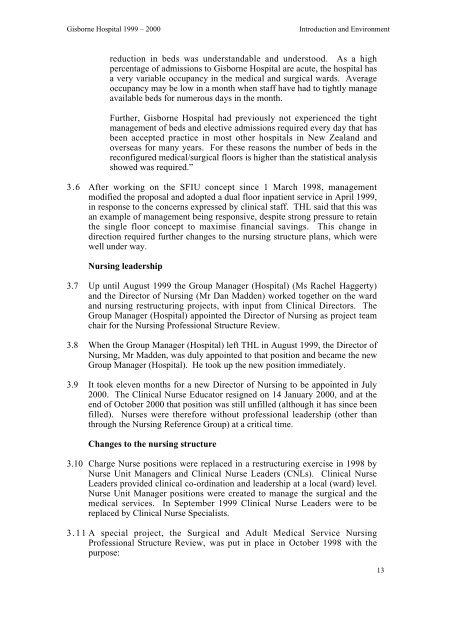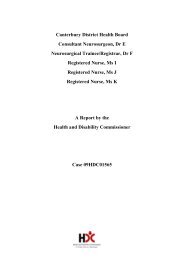Gisborne Hospital Report - Health and Disability Commissioner
Gisborne Hospital Report - Health and Disability Commissioner
Gisborne Hospital Report - Health and Disability Commissioner
You also want an ePaper? Increase the reach of your titles
YUMPU automatically turns print PDFs into web optimized ePapers that Google loves.
<strong>Gisborne</strong> <strong>Hospital</strong> 1999 – 2000<br />
Introduction <strong>and</strong> Environment<br />
reduction in beds was underst<strong>and</strong>able <strong>and</strong> understood. As a high<br />
percentage of admissions to <strong>Gisborne</strong> <strong>Hospital</strong> are acute, the hospital has<br />
a very variable occupancy in the medical <strong>and</strong> surgical wards. Average<br />
occupancy may be low in a month when staff have had to tightly manage<br />
available beds for numerous days in the month.<br />
Further, <strong>Gisborne</strong> <strong>Hospital</strong> had previously not experienced the tight<br />
management of beds <strong>and</strong> elective admissions required every day that has<br />
been accepted practice in most other hospitals in New Zeal<strong>and</strong> <strong>and</strong><br />
overseas for many years. For these reasons the number of beds in the<br />
reconfigured medical/surgical floors is higher than the statistical analysis<br />
showed was required.”<br />
3.6 After working on the SFIU concept since 1 March 1998, management<br />
modified the proposal <strong>and</strong> adopted a dual floor inpatient service in April 1999,<br />
in response to the concerns expressed by clinical staff. THL said that this was<br />
an example of management being responsive, despite strong pressure to retain<br />
the single floor concept to maximise financial savings. This change in<br />
direction required further changes to the nursing structure plans, which were<br />
well under way.<br />
Nursing leadership<br />
3.7 Up until August 1999 the Group Manager (<strong>Hospital</strong>) (Ms Rachel Haggerty)<br />
<strong>and</strong> the Director of Nursing (Mr Dan Madden) worked together on the ward<br />
<strong>and</strong> nursing restructuring projects, with input from Clinical Directors. The<br />
Group Manager (<strong>Hospital</strong>) appointed the Director of Nursing as project team<br />
chair for the Nursing Professional Structure Review.<br />
3.8 When the Group Manager (<strong>Hospital</strong>) left THL in August 1999, the Director of<br />
Nursing, Mr Madden, was duly appointed to that position <strong>and</strong> became the new<br />
Group Manager (<strong>Hospital</strong>). He took up the new position immediately.<br />
3.9 It took eleven months for a new Director of Nursing to be appointed in July<br />
2000. The Clinical Nurse Educator resigned on 14 January 2000, <strong>and</strong> at the<br />
end of October 2000 that position was still unfilled (although it has since been<br />
filled). Nurses were therefore without professional leadership (other than<br />
through the Nursing Reference Group) at a critical time.<br />
Changes to the nursing structure<br />
3.10 Charge Nurse positions were replaced in a restructuring exercise in 1998 by<br />
Nurse Unit Managers <strong>and</strong> Clinical Nurse Leaders (CNLs). Clinical Nurse<br />
Leaders provided clinical co-ordination <strong>and</strong> leadership at a local (ward) level.<br />
Nurse Unit Manager positions were created to manage the surgical <strong>and</strong> the<br />
medical services. In September 1999 Clinical Nurse Leaders were to be<br />
replaced by Clinical Nurse Specialists.<br />
3.11 A special project, the Surgical <strong>and</strong> Adult Medical Service Nursing<br />
Professional Structure Review, was put in place in October 1998 with the<br />
purpose:<br />
13
















